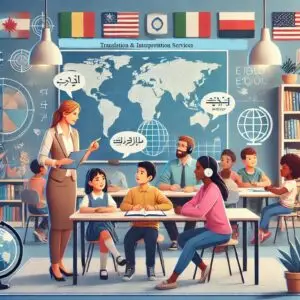 Bridging the Communication Gap in Public Schools: The Role of Translation and Interpretation Services
Bridging the Communication Gap in Public Schools: The Role of Translation and Interpretation Services
Introduction
In today’s diverse and interconnected world, public schools play a vital role in strengthening communication in Public Schools. Language barriers can create significant challenges, impacting communication, learning, and overall success.
Translation and interpretation services are essential for overcoming these barriers. They foster inclusive learning environments, promote equity, and ensure all students and families have access to the education they deserve.
This article explores how translation and interpretation services empower schools to build effective communication channels and embrace cultural understanding.
The Importance of Clear Communication in Education
Effective communication is the cornerstone of successful education. When language barriers exist:
- Students struggle to understand lessons and engage in learning.
- Teachers face challenges in assessing student progress and providing individualized support.
- Parents feel disconnected, making it harder to support their child’s education.
Translation and interpretation services address these challenges by ensuring everyone involved in the educational process can communicate clearly and effectively.
Learn more about the importance of communication in education at Edutopia.
How Translation Services Help
Translation services enable schools to:
- Provide students with learning materials in their native language, improving comprehension and engagement.
- Facilitate parent-teacher communication, ensuring parents can actively participate in their child’s education.
- Create inclusive environments where language is no longer a barrier to success.
For additional insights on the role of translation services in public schools, visit Education Week.
Identifying Language Needs in Schools
To effectively implement translation and interpretation services, schools must first understand the linguistic needs of their students. This involves:
- Analyzing Demographics: Use data to identify the most common languages spoken by students and families.
- Conducting Research: Stay informed about linguistic trends in education.
- Allocating Resources: Focus on languages with the highest demand for services.
Learn about analyzing demographic data at the National Center for Education Statistics.
Providing Accessible Learning Materials
Translated learning materials are critical for student success. Schools should prioritize translating:
- Textbooks: Ensure key academic content is accessible to all students.
- Assignments: Help non-native speakers fully engage with coursework.
- Supplementary Resources: Offer bilingual or multilingual support materials to meet diverse learning needs.
Discover tips for creating accessible materials at Colorín Colorado.
Enhancing Parent-Teacher Communication
Parent-teacher collaboration is vital for student growth. Translation and interpretation services ensure clear communication during:
- Parent-Teacher Conferences: Enable discussions about academic progress and challenges.
- School Meetings: Support effective partnerships between families and educators.
Explore best practices for improving parent-teacher communication at the Harvard Family Research Project.
Supporting School Events and Meetings
Translation and interpretation services play a key role in making school events accessible, including:
- Open Houses: Encourage family participation.
- School Board Meetings: Allow non-English-speaking families to share their perspectives.
Learn how to plan inclusive events with guidance from Learning for Justice.
Assisting with Individual Education Plans (IEPs)
For students with disabilities, clear communication is critical during the IEP process. Translation and interpretation services help:
- Families understand evaluations and services.
- Schools develop effective, individualized strategies for student success.
Find resources for supporting families with IEPs at Understood.org.
Supporting English Language Learners (ELLs)
Teachers play a vital role in identifying and supporting students who need English language assistance. Schools can provide:
- Bilingual Education Programs: Promote academic growth while teaching English.
- Language Development Classes: Help students build English proficiency.
- Targeted Resources: Ensure ELL students have the tools they need to succeed.
Explore resources for ELL support at TESOL International Association.
Enhancing Inclusivity for Non-English-Speaking Families
To create a welcoming environment, schools can offer:
- Multilingual Parent Workshops: Equip families with tools to navigate the school system.
- Community Resource Connections: Link families with local support services.
- Enrollment Assistance: Provide interpretation during registration processes.
For additional family support resources, and the role of translation services in public schools, visit the Migration Policy Institute.
Fostering Inclusivity and Cultural Understanding
Translation and interpretation services help schools:
- Promote Cultural Understanding: Encourage respect for diversity among students and families.
- Build Inclusive Communities: Ensure every student feels valued and supported.
Learn how schools can foster cultural understanding at Edutopia.
Preparing Students for a Global Society
Translation services prepare students to succeed in a globalized world by:
- Encouraging Cross-Cultural Communication: Help students engage with diverse perspectives.
- Building Skills for Global Success: Equip students to thrive in international settings.
Explore the benefits of global education at the Global Partnership for Education.
Addressing Challenges and Innovating Solutions
While translation and interpretation services are essential, schools often face challenges such as:
- Budget Constraints: Implementing cost-effective strategies.
- Resource Limitations: Addressing the needs of diverse language groups.
- Collaboration Opportunities: Partnering with community organizations to expand services.
Find innovative solutions for educational challenges at Education Commission of the States.
Conclusion
The role of translation and interpretation services in schools is indispensable for bridging communication gaps. By fostering clear communication and promoting cultural understanding, schools can provide equitable education for all students, empowering them to thrive in an increasingly interconnected world.
Take the next step: Contact us to learn how we can help your school implement effective translation and interpretation services.

